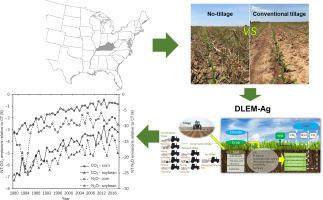Agricultural Systems ( IF 6.1 ) Pub Date : 2021-12-26 , DOI: 10.1016/j.agsy.2021.103355 Yawen Huang 1 , Bo Tao 1 , Yanjun Yang 1 , Xiaochen Zhu 2 , Xiaojuan Yang 3 , John H. Grove 1 , Wei Ren 1

|
CONTEXT
No-tillage (NT) is a conservation practice that aims to minimize soil disturbance and improve crop production. However, NT effects on crop production remain controversial due to the spatial heterogeneity of climate and soil conditions. Some studies argued that NT might offset its greenhouse gas (GHG) mitigation potential in agriculture by promoting soil N2O emissions.
OBJECTIVE
This study used a process-based agroecosystem model (DLEM-Ag) along with spatially explicit environmental datasets to quantify the long-term effects of NT on crop yield and GHG emissions in corn and soybean cropping systems in the state of Kentucky (USA) from 1980 to 2018.
METHODS
The DLEM-Ag was used to quantify the long-term effects of NT on crop yield and GHG emissions in corn and soybean cropping systems in the state of Kentucky. Three spatiotemporal tillage scenarios, i.e., historical varying tillage, consistent conventional tillage (CT), and consistent NT, were adopted to simulate changes in crop yield and GHG emissions.
RESULTS AND CONCLUSIONS
Overall, our results showed that NT could reduce soil CO2 (−1.6% for corn and −4.53% for soybean) and N2O emissions (−10.5% for corn and −19.6% for soybean) in Kentucky, as compared to CT, although corn and soybean yields with NT were not significantly different from those with CT. Our further analysis suggested that air temperature and soil clay content were the two main factors influencing NT advantages in reducing GHG emissions. The increased temperature decreased the benefits of mitigating GHG emissions, while high clay content soils had less N2O emission under NT.
SIGNIFICANCE
This study represents one of few attempts to quantify the effects of NT on crop yield and soil GHG emissions at the regional scale using an agroecosystem modeling approach. The findings from this study provide insights into how NT can enhance agroecosystem production stability and support climate change mitigation. This information may be used by the scientific community and policymakers working on practical technologies to mitigate climate change from agriculture.
中文翻译:

在肯塔基州玉米和大豆种植系统中模拟免耕对作物产量和温室气体排放的影响:1980-2018
语境
免耕 (NT) 是一种保护措施,旨在最大限度地减少土壤干扰并提高作物产量。然而,由于气候和土壤条件的空间异质性,NT 对作物生产的影响仍然存在争议。一些研究认为,NT 可能会通过促进土壤 N 2 O 排放来抵消其在农业中的温室气体 (GHG) 减排潜力。
客观的
本研究使用基于过程的农业生态系统模型 (DLEM-Ag) 以及空间明确的环境数据集来量化 NT 对美国肯塔基州玉米和大豆种植系统作物产量和温室气体排放的长期影响。 1980 年至 2018 年。
方法
DLEM-Ag 用于量化 NT 对肯塔基州玉米和大豆种植系统中作物产量和温室气体排放的长期影响。三种时空耕作情景,即历史变化耕作、一致常规耕作(CT)和一致NT,被用来模拟作物产量和温室气体排放的变化。
结果和结论
总体而言,我们的结果表明,与 CT 相比,NT 可以减少肯塔基州的土壤 CO 2(玉米 -1.6% 和大豆 -4.53%)和 N 2 O 排放(玉米 -10.5% 和大豆 -19.6%) ,尽管使用 NT 的玉米和大豆产量与使用 CT 的玉米和大豆产量没有显着差异。我们的进一步分析表明,气温和土壤粘土含量是影响 NT 在减少温室气体排放方面优势的两个主要因素。温度升高降低了减少温室气体排放的好处,而高粘土含量土壤在 NT 下的N 2 O 排放较少。
意义
这项研究是使用农业生态系统建模方法在区域范围内量化 NT 对作物产量和土壤温室气体排放影响的少数尝试之一。这项研究的结果提供了有关 NT 如何增强农业生态系统生产稳定性和支持减缓气候变化的见解。这些信息可能会被科学界和政策制定者使用,以利用实用技术来缓解农业气候变化。











































 京公网安备 11010802027423号
京公网安备 11010802027423号